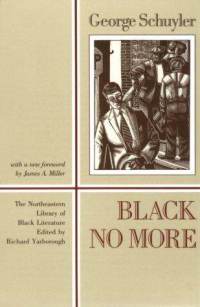 | |
| Author | George S. Schuyler |
|---|---|
| Language | English |
| Genre | Satire, Afrofuturism |
| Publisher | New York, Macaulay Co. |
Publication date | 1931 |
| Media type | |
| Pages | 250 |
| OCLC | 5760472 |
| 813'.52--dc21 | |
Black No More: Being an Account of the Strange and Wonderful Workings of Science in the Land of the Free, A.D. 1933-1940 is a 1931 Harlem Renaissance satire on American race relations by George S. Schuyler. In the novel, Schuyler targets both the Ku Klux Klan and NAACP in condemning the ways in which race functions as both an obsession and a commodity in early twentieth-century America. The central premise of the novel is that an African American scientist invents a process that can transform Black people into white people. Those who have internalized white racism, those who are tired of inferior opportunities socially and economically, and those who simply want to expand their sexual horizons, undergo the procedure. As the country "whitens", the economic importance of racial segregation in the South as a means of maintaining elite white economic and social status becomes increasingly apparent, as the South relies on Black labor through sharecropping.
Contents
- Black No More and Afrofuturism
- Plot
- Preface
- Story
- Critical reception
- Jane Kuenz
- Treva D. Lindsey
- Sonnet H. Retman
- Legacy
- Adaptation
- Publication history
- References
- External links
The novel is known not only for its satiric bite and inventive plot machinations, but also for its focus on racially motivated economic injustice and the caricatures of prominent figures of the American 1920s including W. E. B. Du Bois, Marcus Garvey, James Weldon Johnson, Madam C. J. Walker and others. The novel represents a cornerstone of the New Negro Movement in its transformative discussion of the aesthetic and cultural traditions present in African American art, in which the social concept of Blackness is challenged. It is included in the 2011 Library of America collection "Harlem Renaissance: Four Novels of the 1930s". [1]
Black No More's aspects of science fiction regarding the sanitarium, and the issues it tackles regarding race relations and depictions of issues people of color face, put the novel under the umbrella of Afrofuturism. Black No More is one of the first novels written in this genre defined by the term coined by Mark Dery 60 years later. [2]